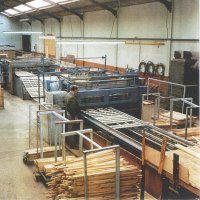
Wirebound containers have been a part of the packaging industry for nearly 100 years. The versatility of this equipment permits a variety of container designs to be produced. In short, wirebound containers are manufactured by fastening slats and/or panels to cleats with a binding wire. Produced in mat form the binding wire between mats are cut, formed into loops and securely clinched on either end of mat. When the mat is assembled, the loops threaded and anchored, the container and product are ready for shipment. These containers fall into two basic categories: standard containers (fruits, vegetables, seafood etc) and industrial/military.
Elements used in construction range from a variety of products: lumber of multiple thickness and species, veneer, OSB, plywood and masonite; binding wires of various gauges, strapping and fasteners of various gauges and lengths. Add a choice of closures, container inserts and blocking components from a wide array of materials and you can afford your customer a quality packaging product that is second to none.
The inherent benefits that you or your customer will realize when using wirebounds containers:
- Custom Manufacture - each container is designed for a given product in order to provide maximum protection at minimum cost.
- Ease of Assembly - shipped to the user in knocked-down form, wirebounds are quickly and easily assembled using simple hand tools.
- Weather Resistance - unlike corrugated containers which weaken when wet or stored in high humidity conditions, wirebounds retain their strength regardless of climatic conditions.
- Versatility in Design - can be used as expendable packaging or reusable containers in a closed-loop system. Will handle single or bulk items. Wirebounds are highly stackable, easily palletized and can provide visual inspection of product throughout transit and distribution. They are readily handled with conveyors, fork lifts or hand trucks.